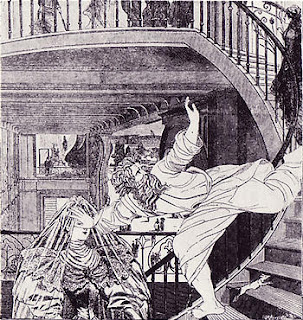Hello! And welcome to my blog. This space will serve to explore different mark making techniques and their respective advantages to get a better understanding of the physical tools I have at hand as a visual artist and designer. This first post is an investigation into the versatility of Indian ink. I hope you enjoy it!
This effect was created by placing a blot of ink on an A3 sheet of paper and then splattering it by blowing at it through a straw once and with a lot of force. As you can see, this made the ink "jump" across the page! I quite like how it turned out. The image is dynamic and has a strong sense of direction: It is clear where the ink originated and that some energy must have been invested in spreading it across the page as it does. Also, the contrast between the heavy blot itself and the light splattered streaks makes the image quite interesting to look at. As a design device, this technique could help to make a composition playful and dynamic.


The two images above were created by placing blots of ink on paper and then blowing at them with straws, this time moving the straws back and forth in swift, sharp zig zag movements. This way, the ink spread out like light twigs branching from heavy centres or stems. The effect is eerie and elegant at the same time; the creations look like something you would find in a dark enchanted forest (a gnarly tree with lots shoots and a weird spider, maybe?). Both images seem to convey an idea of growth, as the streaks and twigs and lines can always be traced back to their origin. I quite like how the blowing has created these intricate textures that also extend to the bits that are fully covered in ink (like the spider's body in the first image) by means of unevenly thick layers of ink.

This pattern was created using a round, very dry brush. As some of the hair on the brush had hardened, it somewhat functioned like a bunch of pen tips grouped together. I quite like the intricate but slightly messy effect, which gives every stroke a depth and interest that could never be achieved by symmetry or a tidier method.
This image invites you to make a direct comparison between different techniques. All of them include the use of a fairly dry brush. Some of them involve using the brush like a stamp (the two upper ones, for instance), other work with strokes (the middle and lower right ones). The middle left square demonstrates that a shaded, dense texture can be created. The bottom right square conveys movement through waves. The bottom left square is particularly interesting because all the dots were created using the same technique and yet they all look really quite different!
This image mainly serves to demonstrate what a thin line can be produced by a dry brush! What a great way to create more subtle textures. I think the fine lines somewhat look like etchings.
This simple little image is my favourite! The frayed strokes/dots are dynamic and seem to suggest movement and energy. Their ragged texture makes them interesting to look at but due to the clean white space around them the image retains a fairly tidy look.
All of these patterns were created by using paper stamps (from tissue and heavy drawing paper), either by crumpling up the paper and dipping it into the in or rolling it up and using the thin end bits to soak it up. I particularly like the darker ovals that look like penguins! The three rows or circle below them show how a colour gradient can be created by not topping up the ink on the stamp and working with it until the ink is used up. I like how diverse the outcomes of the stamping are! Some of them look clearly defined, others create mushy textures.
Another dry brush experiment. This time, the effect is less defined and reminds me of charcoal because of the way the half-dry paint has been smeared across the paint.
Here, a dry brush has been dragged across the page in parallel lines. The image is simple, but effective and unobtrusive enough to provide an interesting design background.
Unfortunately, the quality of the scan obscures the fact that the upper black bit actually glitters when held into the light! The effect was created by rubbing a fairly hard brush against the paper in short zig zag movements so that tiny air bubbles were generated. The glittery bits are the remainders of said bubbles and produce a very interesting texture.
This was created using two different techniques: splattering the ink by flicking a medium size brush towards the paper (larger blot lines) and spraying it by brushing against its hair with my thumb (small blot areas). The contrast between the clear thick lines and the softer spotty areas makes it look messy but interesting. Both looks could be useful in livening up designs as they create a distinct texture (small dots) and a sense of movement (blotted lines).



































